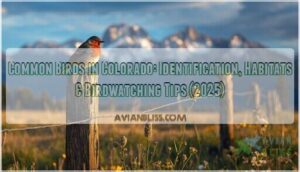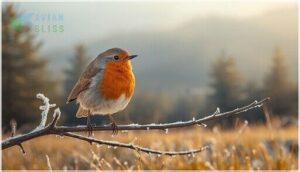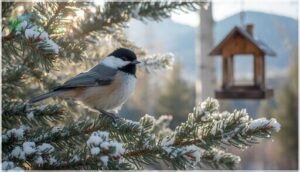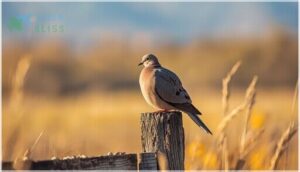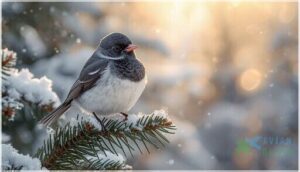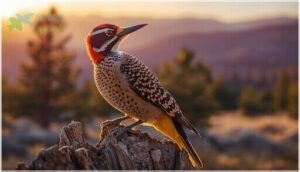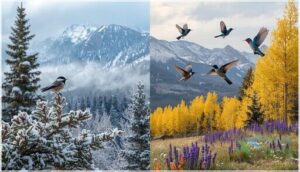This site is supported by our readers. We may earn a commission, at no cost to you, if you purchase through links.
You step outside on a crisp Colorado morning, and within minutes, you’ve likely spotted a flash of red-orange breast or heard the cheerful trill of a chickadee. Colorado’s elevation changes—from 3,300 feet on the plains to over 14,000 feet in the Rockies—create a mosaic of habitats that support more than 500 bird species throughout the year.
Some, like the American Robin and House Finch, appear so regularly in backyards that you might overlook just how well-adapted they are to Colorado’s unique climate and terrain. Others arrive only when conditions align perfectly with their seasonal needs.
Understanding which common birds in Colorado you’re seeing, where they prefer to spend their time, and what drives their movements gives you a clearer picture of the landscape itself—and sharpens your ability to identify the next species that catches your eye.
Table Of Contents
- Key Takeaways
- Most Common Birds in Colorado
- Year-Round and Seasonal Birds
- Key Bird Habitats Across Colorado
- How to Identify Colorado’s Birds
- Conservation and Birdwatching Tips
- Frequently Asked Questions (FAQs)
- What bird calls can I expect to hear in Colorado?
- How do Colorados birds adapt to high altitudes?
- Which Colorado birds are most likely to visit backyard feeders?
- Are there any birds unique to Colorados ecosystem?
- Whats the best time of year for birdwatching in Colorado?
- What do Colorado birds eat in winter?
- How do I attract hummingbirds to my yard?
- When is the best time for birdwatching in Colorado?
- What birds of prey live in Colorado?
- How does altitude affect bird species distribution?
- Conclusion
Key Takeaways
- Colorado’s dramatic elevation range—from 3,300 to over 14,000 feet—creates distinct habitat zones that support more than 500 bird species, with year-round residents like American Robins and Black-capped Chickadees thriving alongside seasonal migrants that follow the state’s three major flyways.
- Beak shape directly reveals feeding strategy: seed-cracking finches have short, powerful bills generating over 15 Newtons of force, while insect-hunting chickadees use precision tweezers and woodpeckers wield chisel tips up to 48mm long for drilling into wood.
- Grassland bird populations have plummeted over 60% in five decades due to habitat fragmentation, with species like the pinyon jay losing 70% of their numbers and the Gunnison Sage-Grouse declining to just 2,700 individuals.
- You can support struggling bird populations by planting native species like Gambel Oak and Serviceberry, maintaining layered vegetation for nesting structure, and practicing responsible birdwatching by staying on trails and avoiding call playback that stresses birds.
Most Common Birds in Colorado
Colorado’s backyards, parks, and trails are home to a variety of familiar birds you’ll spot throughout the year. Each species brings its own colors, calls, and habits to your daily walks or mornings by the window.
Here’s a look at some of the birds you’re most likely to encounter across the state.
American Robin
The American Robin stands out among Colorado’s common bird species, yet its population decline is worth noting. Their breeding habits adapt to urban and forest habitats, and migration patterns vary—some robins stay year-round, others travel south. Bird identification is easy with their orange-red breast.
You’ll often spot robins foraging on lawns, running and pausing as they hunt for worms. They’re known to breed in Texas from March to August.
Black-capped Chickadee
If you’ve watched a backyard feeder in Colorado, chances are you’ve seen the Blackcapped Chickadee. These small, sociable birds thrive in mixed woodlands and urban parks, making them favorites for Birdwatching in Colorado. They’re known for their distinctive chick-a-dee-dee call.
Their adaptive Feeding Habits and clever Nesting Behavior keep Population Trends stable. Habitat Conservation—especially preserving dead trees—helps ensure this Common Bird Species remains a year-round presence.
House Finch
Just as you spot chickadees in winter, the House Finch is another regular among Colorado’s Backyard Birds. With bold red plumage on males, they’re easy for bird identification.
Their Nesting Habits include building open cup nests in planters or trees. Diet Preferences lean toward seeds and fruit.
Finch Migration is short-range, and Population Trends remain strong despite occasional Health Concerns.
Mourning Dove
After finches, Mourning Doves are a familiar sight among Colorado’s backyard birds. With chubby bodies and soft gray plumage, they’re easy for bird identification. You’ll find them nesting statewide, adapting to everything from urban gardens to prairie edges.
Dove Migration sends many south each fall, while strong Population Size and flexible Breeding Habits keep them thriving despite changing Harvest Trends.
Dark-eyed Junco
Think of the Dark-eyed Junco as Colorado’s winter guest. You’ll see these small, round bird species foraging under feeders or along snowy paths. Their Junco Migration brings both resident and visiting flocks to forests and backyards.
With adaptable Habitat Preferences and a varied Diet, they thrive statewide. Stable Conservation Status means you can enjoy their unique bird behavior and Breeding Habits year after year.
European Starling
You’ll recognize the European Starling by its iridescent feathers and loud chatter. This Invasive Species arrived in 1890 and now numbers over 85 million across North America.
They outcompete native bird species in Colorado through Nesting Competition, cause Agricultural Impact at feedlots, and act as a Disease Vector.
Control Methods include trapping and managed pesticide use to protect local bird behavior and bird watching opportunities.
American Goldfinch
You’ll often see the American Goldfinch flashing its bright yellow plumage in Colorado’s fields and backyards year-round. This bird species thrives on seed preferences like thistle and sunflower, displaying acrobatic feeding behavior as it hangs upside down at feeders.
For bird watching enthusiasts, migration triggers include temperatures near 0°F, prompting winter survival movements southward. They use nesting materials like plant fibers during their late-summer breeding season, making bird identification straightforward.
Downy Woodpecker
You’ll spot the Downy Woodpecker, North America’s smallest woodpecker species, flashing its black-and-white plumage throughout Colorado’s woodlands and backyards year-round. Males display a distinctive red nape patch for bird identification.
Their feeding patterns focus on wood-boring insects and larvae, though they’ll eagerly visit your suet feeders.
With excellent conservation status and adaptable nesting habits in dead trees, this bird species thrives in diverse woodland ecology across the state.
Hairy Woodpecker
You might confuse the Hairy Woodpecker with its smaller cousin, but this bird species features a longer, chisel-like bill and larger body, making bird identification easier with practice. Found year-round in Colorado’s mature forests below 6,500 feet, these birdwatching favorites excel at pest control by devouring wood-boring beetles.
- Dietary Habits: Over 75% insects, including bark beetles and moth larvae
- Nesting Behavior: Excavates fresh cavities in aspen trees each breeding season
- Habitat Conservation: Thrives in stable population trends across Colorado’s woodlands
- Population Trends: 8.9 million individuals maintain healthy numbers statewide
Northern Flicker
You’ll know a Northern Flicker by its brown, spotted body and distinctive yellow wing flashes in flight—Colorado’s most common woodpecker. This bird species thrives everywhere from urban parks to mountain forests, though habitat loss and starling competition for nesting cavities threaten populations.
The flicker diet consists mainly of ground-dwelling ants, making them unique among woodpeckers. Watch for their undulating flight pattern during birdwatching excursions.
Year-Round and Seasonal Birds
Colorado’s bird population shifts with the seasons, giving you a mix of familiar faces and exciting visitors throughout the year. Some species stick around no matter how cold it gets, while others follow ancient migration routes that bring them through the state only during specific months.
Understanding which birds you can expect to see—and when—helps you make the most of your birdwatching adventures.
Year-Round Resident Species
Throughout all four seasons, you’ll find several bird species in Colorado that never leave. The American Robin tops the list, frequenting backyards and parks across urban populations statewide. Black-capped Chickadees demonstrate impressive winter survival through seed caching, while House Finches show strong habitat adaptation near human dwellings.
Downy Woodpeckers and Northern Flickers maintain population stability year-round, their breeding habits tied to Colorado’s diverse landscapes.
Migratory Birds and Their Patterns
Migration timing in Colorado depends heavily on the three major flyways that cross the state—Central, Pacific, and Mississippi. You’ll witness the most avian migration patterns from mid-April to early June, when migratory birds travel north, and again during fall, usually late August through October.
Key patterns include:
- Nocturnal movement: Bird migration begins 30 to 45 minutes after sunset, peaking two to three hours later
- Flyway conservation priorities: Habitat restoration sustains millions of birds, with over 17 million using critical stopover sites
- Species monitoring data: Bird tracking reveals 59% of Tree Swallows use the Central Valley route during migration
- Timing variations: Early migrants like Sandhill Cranes pass through March to May, while shorebirds migrate September to November
Notable Spring and Fall Visitors
You’ll see spring’s peak migration in early May, when over 30 warbler species pass through Colorado’s migration bottlenecks. Rare sightings include Black-throated Blue Warblers and Cape May Warblers.
Fall brings slower-paced avian migration—birds linger longer as they head south in September. Watch for unusual visitors like Ruddy Ground Doves and Sabine’s Gulls.
Migration forecasting helps you time your birdwatching trips perfectly.
Key Bird Habitats Across Colorado
Colorado’s landscape offers a rich variety of habitats, and each one attracts a different mix of bird species. Understanding where birds live helps you know where to look and what to expect when you’re out observing.
Here’s a closer look at the key habitats you’ll find across the state and the birds that call them home.
Forests and Woodlands
Colorado’s forests and woodlands host remarkable bird diversity—over 500 species call these habitats home. You’ll spot year-round residents like Black-capped Chickadees and Downy Woodpeckers, while seasonal patterns bring Western Tanagers in summer.
Key habitat characteristics include:
- Conifer and deciduous forests with varied structure
- Riparian zones offering water and nesting sites
- Elevation gradients from foothills to subalpine zones
- Snags and understory vegetation for shelter
Conservation trends show some forest birds declining, making habitat preservation essential for Colorado’s avian populations.
Grasslands and Prairies
Across eastern Colorado, shortgrass prairies support specialized bird communities facing alarming declines—grassland species have dropped over 60% in five decades due to habitat fragmentation and grazing impact. You’ll find Lark Buntings, Horned Larks, and Burrowing Owls in these ecosystems, where habitat preservation and ecosystem balance remain critical.
Playa conservation provides migration stopovers, while thoughtful birdwatching helps document these threatened populations.
Wetlands and Riparian Areas
With 250,000+ shorebirds passing through daily during peak migration, Colorado’s wetlands and riparian zones support 90% of the state’s bird species. You’ll witness remarkable gatherings—20,000 Greater Sandhill Cranes in the San Luis Valley, American Avocets thriving along river corridors.
Water management directly impacts habitat restoration success, making wetland conservation critical for birdwatching opportunities and protecting wildlife conservation priorities statewide.
Urban and Backyard Environments
Surprisingly, urban birding in Colorado attracts species like American Robins, House Finches, and Black-capped Chickadees—your backyard bird watching efforts can reveal over 100 bird species across several years.
Backyard feeders and city wildlife thrive when you provide:
- Diverse seed types in platform and tube feeders
- Native berry-producing shrubs and large trees
- Fresh water sources year-round
Suburban habitats with yard conservation practices support both resident and migratory bird species throughout Colorado’s seasons.
Mountain and Alpine Regions
When you venture above the treeline in Alpine Ecosystems like Rocky Mountain National Park, you’ll encounter specialized species adapted to High Altitude and Rocky Terrain. The Mountain Bluebird, Colorado’s state bird, thrives here alongside White-tailed Ptarmigan and American Dippers in fast-moving streams.
Mountain Birding reveals how these species maintain ecosystem balance, making Conservation Efforts critical as wildlife in Colorado faces habitat pressures from drought and wildfires.
How to Identify Colorado’s Birds
Identifying birds in Colorado gets easier once you know what to look for. Whether you’re watching a bird at your feeder or spotting one on a trail, a few key features will help you figure out what species you’re seeing.
Let’s break down the main identification clues you can use in the field.
Plumage and Color Patterns
Plumage and Color Patterns reveal what’s happening beneath the surface—literally. When you’re learning Bird Identification Techniques, understanding Feather Structure helps you spot the difference between species sharing similar habitats.
Consider these key patterns:
- American Goldfinch males shift from vivid yellow breeding plumage to drab olive-brown through seasonal Molt Patterns, conserving energy during winter months.
- Northern Flicker morphs display red or yellow flight feather shafts depending on regional Color Genetics.
- European Starlings show stunning Iridescent Colors—purple and green sheens that shimmer in breeding season but appear black from afar.
These variations reflect millions of years of Plumage Evolution shaped by survival and mate attraction.
Beak Shapes and Sizes
Beak morphology provides valuable insights into a bird’s diet even before observing its feeding behavior. Think of beaks as specialized tools—each shape reflects millions of years of beak evolution fine-tuning feeding strategies. Observing these bird adaptation features sharpens your bird identification techniques during birdwatching outings, revealing connections between species diversity, bird behavior, and ecology across Colorado’s landscapes.
| Species | Beak Type | Primary Diet |
|---|---|---|
| American Goldfinch | Conical, 9–10 mm | Seeds (high-pressure cracking) |
| Black-capped Chickadee | Narrow, tweezer-like, 9–11 mm | Insects from bark crevices |
| Northern Flicker | Chisel-tipped, 27–48 mm | Ants, wood-boring insects |
| Mourning Dove | Narrow, decurved, 9.5 mm | Seeds, ground foraging |
| Downy Woodpecker | Straight, pointed, 13–17 mm | Insects excavated from wood |
Seed-eaters like finches sport short, sturdy beaks generating over 15 Newtons of force—perfect for cracking tough hulls. Meanwhile, insectivores such as chickadees use precision tweezers averaging 9–11 mm to extract prey from tight spaces. Woodpeckers display chisel-tipped beaks reaching 27–48 mm, drilling into wood with exceptional efficiency.
Distinctive Calls and Songs
While beak shape tells you what birds eat, bird vocalizations reveal who’s in your neighborhood before you spot them. Melodic structures vary dramatically—the American Robin’s cheerful “cheerily, cheer up” carol differs entirely from the Mourning Dove’s mournful “cooOOoo-wooo-woo-woooo.” Black-capped Chickadees use their recognizable “fee-bee” whistle, while Dark-eyed Juncos emit fluttering trills.
These sonic communications improve wild bird identification during birdwatching outings.
Behavior and Feeding Habits
Beyond identifying birds by sight and sound, you’ll want to watch how they move and feed. Foraging strategies reveal species identity quickly—American Robins hop across lawns hunting invertebrates, while Black-capped Chickadees glean from branches, often hanging upside down. Dietary adaptations shift with seasonal changes; chickadees consume 90% insects in summer but switch to 50% seeds during winter.
- House Finches demonstrate submissive social interactions even with smaller species at feeders
- Mourning Doves swiftly fill their crop with seeds, processing 99% grain-based diets on the ground
- Platform feeders attract 92.5% of Colorado’s backyard birds, supporting diverse avian behavior
- Food caching behavior helps chickadees survive scarce periods through stored seeds and insects
- Habitat influence determines whether robins employ “widely foraging” or “sit-and-wait” feeding modes
Conservation and Birdwatching Tips
Colorado’s bird populations face real challenges, from habitat loss to declining numbers in species like the Evening Grosbeak and grassland birds.
But you can make a difference, whether you’re observing birds in your backyard or exploring Rocky Mountain National Park. Here’s what you need to know about protecting these species and enjoying responsible birdwatching.
Threatened and Declining Species
Despite Colorado’s vibrant bird diversity, you’re witnessing a troubling trend. Habitat loss and climate impacts have triggered steep declines, with grassland species like the pinyon jay losing 70% of their populations. The Gunnison Sage-Grouse now numbers just 2,700 individuals.
Colorado’s bird populations are declining sharply—grassland species like the pinyon jay have lost 70% of their numbers due to habitat loss and climate change
Conservation funding aids species recovery through habitat restoration, yet economic effects ripple beyond wildlife—avian conservation and wildlife management are essential to maintaining ecological balance.
Creating Bird-Friendly Spaces
You can reverse these declines right in your backyard. Native plant selection attracts more birds—Gambel Oak and Serviceberry provide essential food and nesting sites. Add habitat structure with layered trees and shrubs, plus reliable food and water through bird feeders and birdbaths.
Urban planning that retains mature trees makes real conservation outcomes possible. Your bird-friendly space aids both resident and migratory species year-round.
Responsible Birdwatching Practices
When you observe birds, stay on marked trails to protect bird-friendly habitats—crossing boundaries accounts for most illegal incidents in birdwatching. Maintain distance from nests, since human presence causes abandonment and increases predation.
Limit call playback, which stresses birds, especially rare species.
These ethical guidelines support wildlife conservation in Colorado while letting you enjoy sustainable tourism and bird behavior and ecology. Wildlife observation works best when you prioritize minimizing disturbance.
Supporting Local Conservation Efforts
Contributing time or funds to habitat restoration amplifies wildlife conservation efforts across Colorado’s landscapes. You’ll find funding opportunities through conservation groups that partner with land trusts, securing grants for grassland and riparian projects.
Engage with community programs that promote sustainable practices, or support policy advocacy for declining species. Environmental education initiatives strengthen bird conservation, connecting wildlife management goals with practical habitat conservation strategies that benefit future generations.
Frequently Asked Questions (FAQs)
What bird calls can I expect to hear in Colorado?
You’ll hear distinctive year-round calls from chickadees, robins, and finches in urban areas, while seasonal variations bring hummingbird trills in summer and junco chirps in winter.
Habitat acoustics differ between mountains, grasslands, and backyards, affecting call frequency and species identification.
How do Colorados birds adapt to high altitudes?
Colorado’s high-elevation avian species employ oxygen optimization through increased hematocrit, metabolic upregulation, and thermal tolerance via dense plumage.
Dietary shifts and altitudinal migration patterns help birds navigate extreme alpine conditions and scarce winter resources.
Which Colorado birds are most likely to visit backyard feeders?
You’ll spot house finches, black-capped chickadees, dark-eyed juncos, and American goldfinches most often at your feeders. Platform feeders attract the widest variety, while suet cages bring in woodpeckers like downies and northern flickers.
Are there any birds unique to Colorados ecosystem?
While Colorado hosts 519 documented bird species, no true endemics exist here. However, you’ll find near-endemics like the Gunnison Sage-Grouse and Brown-capped Rosy-Finch, which depend heavily on Colorado’s alpine birds and sagebrush ecosystems for survival.
Whats the best time of year for birdwatching in Colorado?
Spring migration peaks mid-May, making it Colorado’s best bird watching season. You’ll spot vibrant warblers and hummingbirds during breeding season.
Fall brings raptors, while winter raptors concentrate near water, influenced by habitat and weather patterns.
What do Colorado birds eat in winter?
You might notice robins gathering around berry-laden shrubs instead of hunting worms. That shift happens because Colorado birds adapt their diets when insects disappear, relying on fruits, seeds from feeders, suet, and heated water sources for survival.
How do I attract hummingbirds to my yard?
You’ll need feeders with red components, homemade nectar (one part sugar, four parts water), native tubular flowers like Penstemon, shallow water features, and pesticide-free gardens to attract Broad-tailed and Rufous Hummingbirds throughout Colorado.
When is the best time for birdwatching in Colorado?
Early fall through September offers peak migration activity, while winter’s clear weather and sparse foliage improve visibility.
Dawn and dusk heighten avian activity year-round, with habitat variation influencing seasonal birds across Colorado’s diverse regions.
What birds of prey live in Colorado?
Colorado’s birds of prey include Red-tailed Hawks, Bald Eagles, Golden Eagles, American Kestrels, Prairie Falcons, and Ferruginous Hawks.
These raptors face conservation challenges from habitat loss, though some species show considerable adaptability to human-altered landscapes.
How does altitude affect bird species distribution?
You might think birds flip a coin to pick their home, but elevation gradients actually drive habitat diversity and species turnover in Colorado.
Climate effects shape where avian diversity thrives across ecological habitats.
Conclusion
Over 90% of birdwatchers report that identifying just five species dramatically improves their confidence in the field. You’ve now explored the common birds in Colorado—from robins thriving in backyards to juncos foraging along mountain trails.
Each observation sharpens your understanding of how elevation, habitat, and season shape what you see. Keep your binoculars ready, stay curious about the details, and you’ll find that every outing reveals something new about Colorado’s avian residents.
- https://en.wikipedia.org/wiki/List_of_birds_of_Colorado
- https://www.fcgov.com/naturalareas/mn-res-pdf/birds-in-fortcollins-by-dleatherman.pdf
- https://www.grandchaletcolorado.com/blog/what-is-the-most-common-bird-in-colorado
- https://cunewscorps.shorthandstories.com/-half-of--colorado-s-birds-in-decline-from--climate-change-domino-effects-/index.html
- https://www.birdconservancy.org/birds-by-the-numbers/

